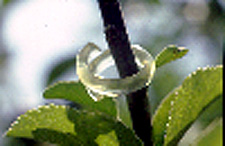
Spiral Pheromone Dispenser
This page was prepared mainly by the
senior
author as part of a project for ENT 4987, Arthropod Management in Fruit
Crops.
Mating disruption offers several advantages over pesticide sprays. Since no toxic residues are left on fruit, it is much safer for agricultural workers. The development of a pest population resistant to mating disruption is highly unlikely. Mating disruption is non-toxic to natural enemies, therefore populations of secondary pests are less likely to reach levels exceeding threshold values. Generally, fewer timing decisions are involved in mating disruption, since dispensers remain in the orchard through the growing season (Pfeiffer 1996).
In 1989, in an apple orchard located in Daleville, Virginia mating disruption was utilized to reduce codling moth damage to 0.9%. An equivalent abandoned control block experienced 39.5% codling moth damage (Pfeiffer et al. 1993). In a study conducted in Capay, California, less than 0.5% fruit damage was achieved with mating disruption in a pear orchard (Barnes et al. 1992).
In order for mating disruption to be an
effective control mechanism, the orchard must meet the following
criteria:
The plot must be at least five acres (2 hectares), previous codling
moth
densities must not have exceeded moderate levels, the orchard must not
be adjacent to uncontrolled plots or other significant sources of
immigrating
codling moths, the orchard must have a regular shape, and the tree
structure
and size must be uniform (Pfeiffer 1996). Attempts to utilize this
methodology
in orchards not meeting these criteria without pesticide sprays have
resulted
in economically significant levels of fruit damage (Howell et al. 1992,
Pfeiffer et al. 1993, and Trimble 1995).

Spiral Pheromone Dispenser |
Several types of pheromone dispensers are available which can easily be placed on the trees. These include plastic rectangles with twist-tie attachments; polyethylene spirals, and polyethylene strips containing wire which allows the strip to be bent around the branch (Pfeiffer 1996). |
Prior to bud break, codling moth pheromone traps should be placed in the orchard at the rate of five per an acre (one in the center and on each corner). When the first codling moth is trapped, pheromone dispensers should be applied. Dispensers should be placed in the orchard at a rate of 400 per acre (1,000/ha) (Pfeiffer et al.1993). It has been found that male and unmated female codling moth activity is greatest in the upper tree canopy, therefore dispensers should be placed in the upper half of the tree for maximum effectiveness (Weissling & Knight 1995). Attach dispensers where they will be shaded in order to minimize photodegredation of the pheromone which results in reduced pheromone release and alteration of the relative concentrations of pheromone components (Brown et al.1992).
In order to control other key pests, such as plum curculio, a petal fall spray should be applied. Because of the tendency of mating disruption to break down in the two border rows, these should be closely monitored and pesticides applied when necessary (Pfeiffer et al. 1993). When selecting pesticides for application, the pesticide's toxicity to natural enemies should be taken into consideration. For Virginia's pesticide recommendations consult the Spray Bulletin for Commercial Tree Fruit Growers, or the Pest Management Guide for Home Fruit. Although shutdown of codling moth traps may indicate successful mating disruption, this is not a reliable test. Therefore, fruit should be periodically examined for codling moth injury (Trimble 1995).
See excellent discussion on codling moth mating disruption from Washington State University.
Sources of Mating Disruption
Products
On-Line:
Pacific
Biocontrol
References
Barnes, M. M., J. G. Millar, P. A. Kirsch & D. C. Hawks. 1992. J. Econ. Entomol. 1274-1277.
Brown, D. F., A. L. Knight, J. F. Howell, C. R. Sell, J. L. Krysan, & M. Weiss. 1992. J. Econ. Entomol. 910-917.
Howell, J. F., A. L. Knight, T. R. Unruh, D. F. Brown, J. L. Krysan, C. R. Sell & P. A. Kirsch. 1992. Control of codling moth in apple and pear with sex pheromone-mediated mating disruption. J. Econ. Entomol. 918-925.
Pfeiffer, D.G., W. Kaakeh , J. C. Killian, M. W. Lachance, & P. Kirsch. 1993. Mating disruption for control of damage for control of damage by codling moth in Virginia apple orchards. Entomol. exp. appl. 67: 57-64.
Pfeiffer, D. G., ed. 1996. Spray Bulletin for Commercial Tree Fruit Growers. Publication 456-419.
Trimble, R. M. 1995. Mating disruption for controlling the codling moth, Cydia pomonella (L.) (Lepidoptera: tortricidae), in organic apple production in southwestern Ontario. Can. Entomol. 127: 493-505.
Weissling, T. J. & A. L.
Knight.
1995. Vertical distribution of codling moth adults in pheromone-treated
and untreated plots. Entomol. Exp. Applic. 77: 271-275.